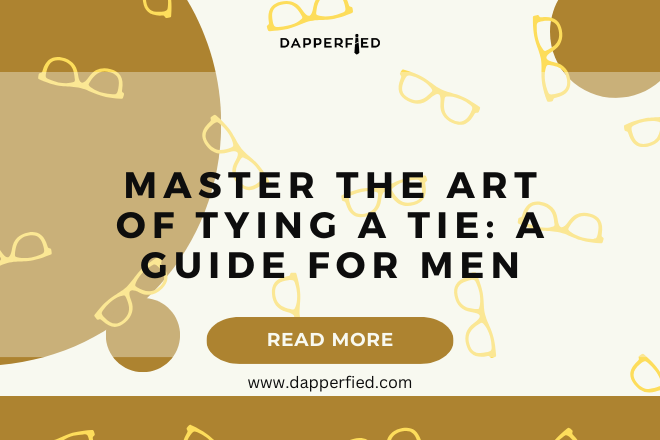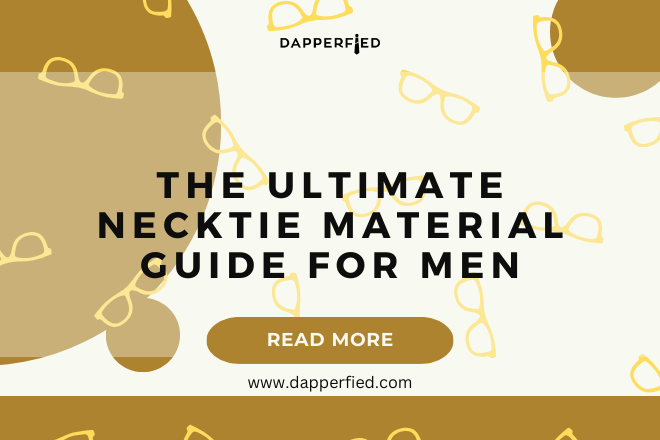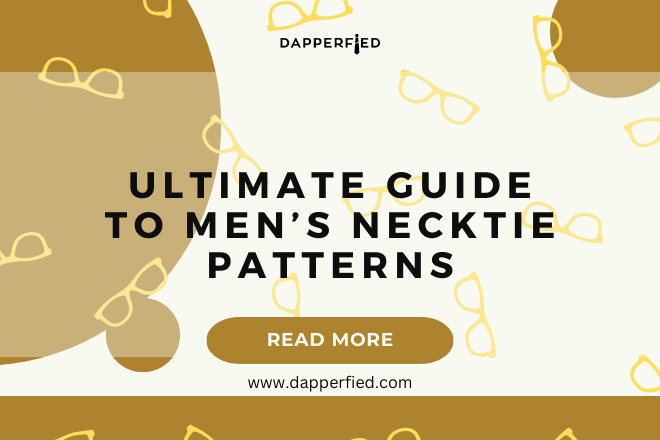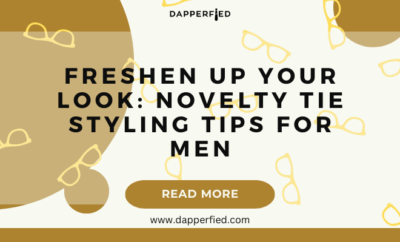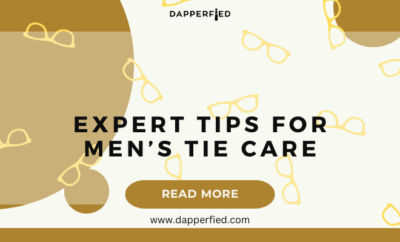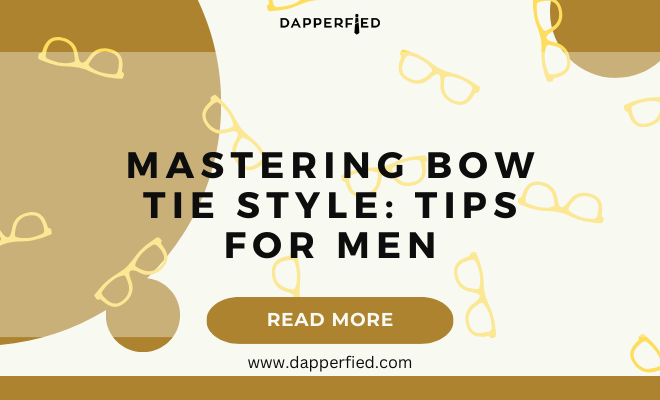
Men's Style
Mastering Bow Tie Style: Tips for Men
When it comes to choosing the right bow tie, there are a few key factors to consider. First and foremost, you’ll want to think about the occasion for which you’ll be wearing the bow tie. For formal events, such as weddings or black-tie affairs, a classic silk bow tie in a solid color or subtle pattern is always a safe bet. However, if you’re looking to make a statement or add a pop of personality to your outfit, you might opt for a bold, vibrant bow tie in a fun print or eye-catching color.
Another important consideration when choosing a bow tie is the size and shape of the bow. A larger, more exaggerated bow tie can make a bold statement and add a touch of drama to your look, while a smaller, more understated bow tie can lend a more classic and refined vibe. Additionally, you’ll want to think about the fabric of the bow tie. Silk is the most traditional and formal option, but there are also bow ties available in materials like cotton, wool, and even leather for a more casual or edgy look.
In addition to considering the occasion, size, shape, and fabric of the bow tie, it’s also important to think about how the bow tie will complement your outfit. Consider the colors and patterns of the clothing you’ll be wearing with the bow tie, and choose a bow tie that will coordinate and enhance your overall look. Ultimately, the right bow tie is one that makes you feel confident and expresses your personal style.
Key Takeaways
- When choosing a bow tie, consider the occasion, your personal style, and the material of the tie.
- Tying the perfect bow tie knot involves adjusting the length and width to achieve a balanced and symmetrical look.
- Pairing bow ties with different outfits requires attention to color coordination and the formality of the event.
- Understanding bow tie etiquette includes knowing when to wear a bow tie, how to properly adjust it, and when to remove it.
- Maintaining and caring for bow ties involves proper storage, cleaning, and handling to ensure longevity and quality.
- Exploring different bow tie styles and materials allows for creativity and individual expression in fashion.
- Embracing individuality with bow tie fashion means experimenting with patterns, colors, and unique accessories to make a statement.
Tying the Perfect Bow Tie Knot
Tying a bow tie can seem like a daunting task, but with a little practice and patience, it’s actually quite simple. There are several different methods for tying a bow tie, but one of the most popular and classic techniques is the “self-tie” method. To begin, drape the bow tie around your neck with one end slightly longer than the other. Cross the longer end over the shorter end, then bring it up and through the loop around your neck. Next, fold the shorter end in half to form the front loop of the bow. Then, take the longer end and drape it over the front loop, creating the back loop of the bow. Finally, tuck the longer end through the loop behind the front loop and adjust the ends to tighten and shape the bow.
Another popular method for tying a bow tie is the “butterfly” or “pre-tied” style. This method involves a pre-tied bow that attaches to your shirt collar with a band or clip. While this method is quick and convenient, it lacks the charm and authenticity of a self-tied bow tie. Whichever method you choose, practice makes perfect when it comes to tying a bow tie. With a bit of patience and persistence, you’ll soon be able to tie a perfect bow every time.
Pairing Bow Ties with Different Outfits
Bow ties are incredibly versatile accessories that can be paired with a wide range of outfits to create different looks. For formal occasions, such as weddings or black-tie events, a classic tuxedo or suit paired with a silk bow tie in a solid color or subtle pattern is always a timeless choice. To add a touch of personality to your formal look, consider opting for a bow tie in a bold color or fun print.
For more casual or everyday wear, bow ties can be paired with everything from dress shirts and blazers to sweaters and even t-shirts. A cotton or wool bow tie in a more relaxed shape or pattern can add a touch of sophistication to a casual outfit without feeling too stuffy or formal. Additionally, bow ties can be worn with both button-up and button-down collared shirts, making them a versatile accessory for any wardrobe.
When it comes to pairing bow ties with different outfits, it’s important to consider the overall aesthetic you’re going for. A classic silk bow tie can elevate a formal look, while a more casual fabric or pattern can add a playful touch to an everyday outfit. Ultimately, experimenting with different combinations and finding what feels right for you is key to mastering the art of pairing bow ties with different outfits.
Understanding Bow Tie Etiquette
| Etiquette | Guidelines |
|---|---|
| When to wear a bow tie | Formal events, weddings, evening affairs |
| Types of bow ties | Silk, satin, velvet, cotton |
| How to tie a bow tie | Self-tie or pre-tied |
| Matching with outfit | Coordinate with shirt or jacket |
| Proper bow tie size | Should not be too big or too small |
Bow ties have long been associated with formal events and occasions, so understanding bow tie etiquette is essential for anyone looking to wear one with confidence. When it comes to formal events like weddings or black-tie affairs, a classic silk bow tie in a solid color or subtle pattern is always appropriate. However, for more casual events or everyday wear, there’s more room for creativity and personal expression when it comes to choosing a bow tie.
In terms of sizing and fit, it’s important to ensure that your bow tie is proportionate to your neck size and the collar of your shirt. A bow tie that is too large or too small can look awkward and out of place, so finding the right fit is crucial. Additionally, when tying your bow tie, make sure that it is centered and symmetrical for a polished and put-together look.
When it comes to color and pattern choices, it’s important to consider the overall aesthetic of your outfit and the event you’ll be attending. For formal events, classic colors like black, navy, and burgundy are always safe choices, while more casual events allow for bolder colors and playful patterns. Ultimately, understanding bow tie etiquette is about striking a balance between tradition and personal style to create a look that feels both appropriate and authentic.
Maintaining and Caring for Bow Ties
Proper maintenance and care are essential for keeping your bow ties looking their best for years to come. When it comes to cleaning silk or other delicate fabric bow ties, it’s best to spot clean them with a gentle detergent and water rather than machine washing them. For tougher stains or more thorough cleaning, consider taking your bow ties to a professional dry cleaner who specializes in delicate fabrics.
Storing your bow ties properly is also important for maintaining their shape and quality. Consider investing in a dedicated bow tie organizer or storage box to keep your collection organized and protected. When not in use, hang your bow ties on a rack or store them flat in their designated storage space to prevent wrinkles and creases.
In addition to cleaning and storage, regular maintenance like ironing or steaming can help keep your bow ties looking crisp and polished. Be sure to follow any care instructions provided by the manufacturer to ensure that you’re treating your bow ties with the proper care they deserve.
Exploring Different Bow Tie Styles and Materials


Bow ties come in a wide variety of styles and materials, each offering its own unique look and feel. Classic silk bow ties are always a popular choice for formal events due to their luxurious sheen and timeless appeal. However, there are also cotton and wool bow ties that offer a more casual and relaxed vibe, making them perfect for everyday wear or more laid-back occasions.
In addition to different materials, there are also various styles of bow ties to consider. The traditional “batwing” style features straight edges and a narrow shape, while the “diamond point” style has angled edges that create a more geometric look. There are also “butterfly” or “thistle” styles that feature wider bows with rounded edges for a more dramatic and statement-making effect.
When exploring different bow tie styles and materials, it’s important to consider how they will complement your personal style and the occasions for which you’ll be wearing them. A classic silk bow tie is always a safe bet for formal events, while experimenting with different materials and styles can add variety and personality to your wardrobe.
Embracing Individuality with Bow Tie Fashion
One of the most exciting aspects of wearing bow ties is the opportunity to embrace individuality and express personal style through fashion. Whether you prefer classic silk bow ties in timeless colors or bold statement-making patterns in unconventional materials, there’s no shortage of options for showcasing your unique taste and personality.
For those who are new to wearing bow ties, experimenting with different colors, patterns, and styles can be an exciting way to discover what feels most authentic and comfortable. Don’t be afraid to step outside of your comfort zone and try something unexpected – after all, fashion is all about self-expression and creativity.
Ultimately, embracing individuality with bow tie fashion is about finding what makes you feel confident and empowered. Whether you’re dressing for a formal event or simply adding flair to an everyday outfit, let your personality shine through in your choice of bow tie – after all, there’s no better accessory for making a statement than one that reflects who you are.
If you’re looking to elevate your style beyond just bow ties, check out this article on how the TV show Mad Men influenced men’s style. The show’s sleek and sophisticated aesthetic has had a lasting impact on modern menswear, and this article from Dapperfied explores 12 ways that the show has influenced men’s fashion. Whether you’re interested in business suits or suit separates, this article offers valuable insights into how to incorporate elements of classic style into your wardrobe. (source)
FAQs
What are some basic bow tie styling tips for men?
Some basic bow tie styling tips for men include choosing the right size and style of bow tie, learning how to tie it properly, and coordinating it with the rest of the outfit.

How do I choose the right size and style of bow tie?
When choosing a bow tie, consider the size of your neck and the proportions of your face. The style of the bow tie should complement the overall look you are trying to achieve, whether it’s formal, casual, or trendy.
What are the different ways to tie a bow tie?
There are several ways to tie a bow tie, including the classic butterfly, the straight-end, and the diamond-point. Each style creates a different look and can be chosen based on personal preference and the occasion.
How do I coordinate a bow tie with the rest of my outfit?
When coordinating a bow tie with the rest of your outfit, consider the color, pattern, and fabric of the bow tie in relation to the shirt, suit, and accessories. It’s important to create a cohesive and balanced look.
Can I wear a bow tie with a casual outfit?
Yes, bow ties can be worn with casual outfits to add a touch of sophistication and style. Pairing a bow tie with a casual shirt and jeans can create a trendy and fashion-forward look.


